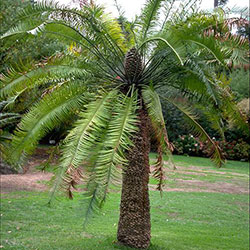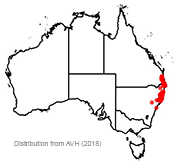Lepidozamia peroffskyana
 |
 |
Scaly Zamia, Pineapple Cycad
Lepidozamia peroffskyana Regel
 Lepidozamia peroffskyana, commonly known as Scaly Zamia or Pineapple Cycad, is in the family Zamiaceae. It is naturally distributed in the wet sclerophyll forests of north-eastern New South Wales and south-eastern Queensland, usually on protected slopes and gullies or rainforest margins and coastal forests on stabilised sand dunes and sand hills. It grows from sea level to about 1000m altitude and it tolerates summer temperatures of about 19 to 32°C and winter temperatures about 6 to 22°C.
Lepidozamia peroffskyana, commonly known as Scaly Zamia or Pineapple Cycad, is in the family Zamiaceae. It is naturally distributed in the wet sclerophyll forests of north-eastern New South Wales and south-eastern Queensland, usually on protected slopes and gullies or rainforest margins and coastal forests on stabilised sand dunes and sand hills. It grows from sea level to about 1000m altitude and it tolerates summer temperatures of about 19 to 32°C and winter temperatures about 6 to 22°C.
Lepidozamia peroffskyana is one of the tallest cycads, growing to seven metres, with arching dark green glossy leaves that look like palm fronds. New leaves are soft, brown and hairy as they emerge but turn green and glossy and flatten out as the leaves harden.
Cones are produced on separate male and female plants. Female cones are 50–60 cm long and 20–25 cm wide, grey-green and barrel shaped and when ripe break apart to release oblong, bright red seeds. Male cones are about 50–60 cm long and 10–12 cm wide, cylindrical and curved, and when about to shed pollen they enlarge in a spiral fashion and can extend to 1 m in length.
Lepidozamia peroffskyana is an attractive plant, easily grown from seed, slow-growing and long-lived. It can tolerate extended dry periods, doesn't require fertilisers and generally requires a minimum of attention which makes it ideal for a low-maintenance garden. The plants prefer sandy loam soil with soil pH of slightly acidic to neutral. They can be grown in full sun but need protection from afternoon sun to avoid scorching of fronds. They prefer filtered sun, and semi-shade situations and can tolerate light frosts. They are great container plants and make excellent indoor plants in well-lit situations. Scale insects can be a problem but can be controlled easily by removing any affected fronds.
These characteristics make Lepidozamia peroffskyana ideal to use as a feature plant, grow in a container or plant in a mixed tropical garden.
Rosella Hampshire, Volunteer Botanical Training Program Participant 2018 and ANBG Horticulturist
Name meaning: Lepidozamia peroffskyanaLepidozamia - from the Greek lepidos, a scale and Zamia, a cycad peroffskyana - after Count Peroffsky, a 19th Century benefactor of the St Petersburg Botanical Garden |
References:
Australian Native Plant Society (2016). Lepidozamia peroffskyana, Available at http://anpsa.org.au/l-per.html [Accessed July 2018].
Daly, G. (2013). Lepidozamia peroffskyana in cultivation, Palm& Cycad Societies of Australia. Available at http://www.pacsoa.org.au/wiki/Lepidozamia_peroffskyana_in_cultivation [Accessed July 2018].
Hill, K.D. (1998). Cycadaceae, Flora of Australia Vol 48. Melbourne: ABRS/CSIRO Australia.
Hill, K.D. (2010). Lepidozamia peroffskyana, The Cycad Pages. Available at http://plantnet.rbgsyd.nsw.gov.au/cgi-bin/cycadpg?taxname=Lepidozamia+peroffskyana [Accessed July 2018].
Hill, K.D. (2010). Lepidozamia peroffskyana, The IUCN Red List of Threatened Species 2010: e.T41996A10600317. Available at http://dx.doi.org/10.2305/IUCN.UK.2010-3.RLTS.T41996A10600317.en [Accessed July 2018].
Kennedy, P. (2013). Lepidozamia peroffskyana, Palm & Cycad Societies of Australia. Available at http://www.pacsoa.org.au/wiki/Lepidozamia_peroffskyana [Accessed July 2018].
Oliff, J. (2009). Australian Cycads, Australian Plants Online, Australian Native Plants Society. Available at http://anpsa.org.au/APOL2009/feb09-s3.html [Accessed July 2018].
![An Australian Government Initiative [logo]](/images/austgovt_brown_90px.gif)

